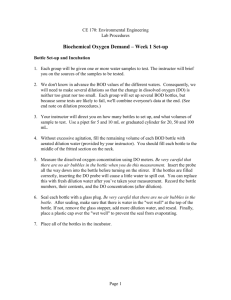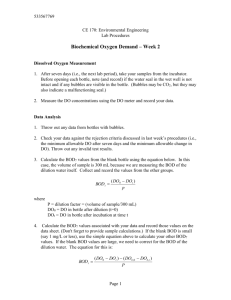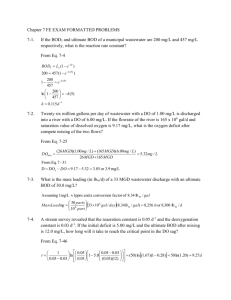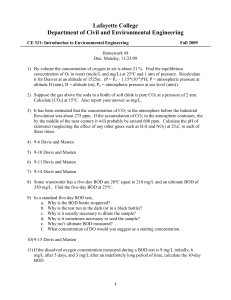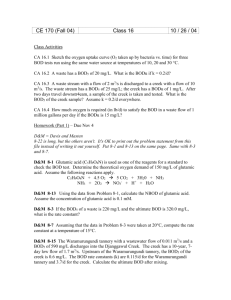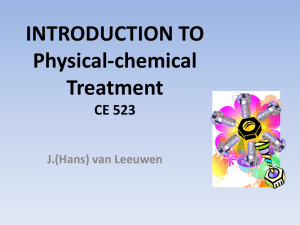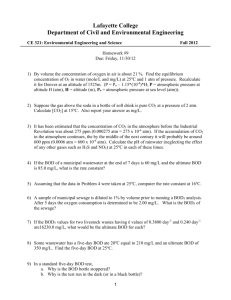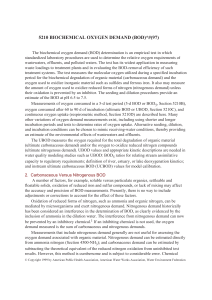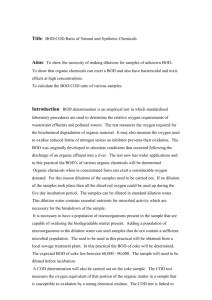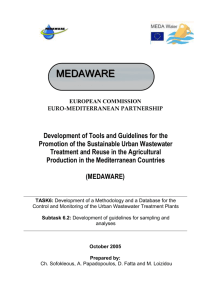Biochemical Oxygen Demand (BOD)
advertisement
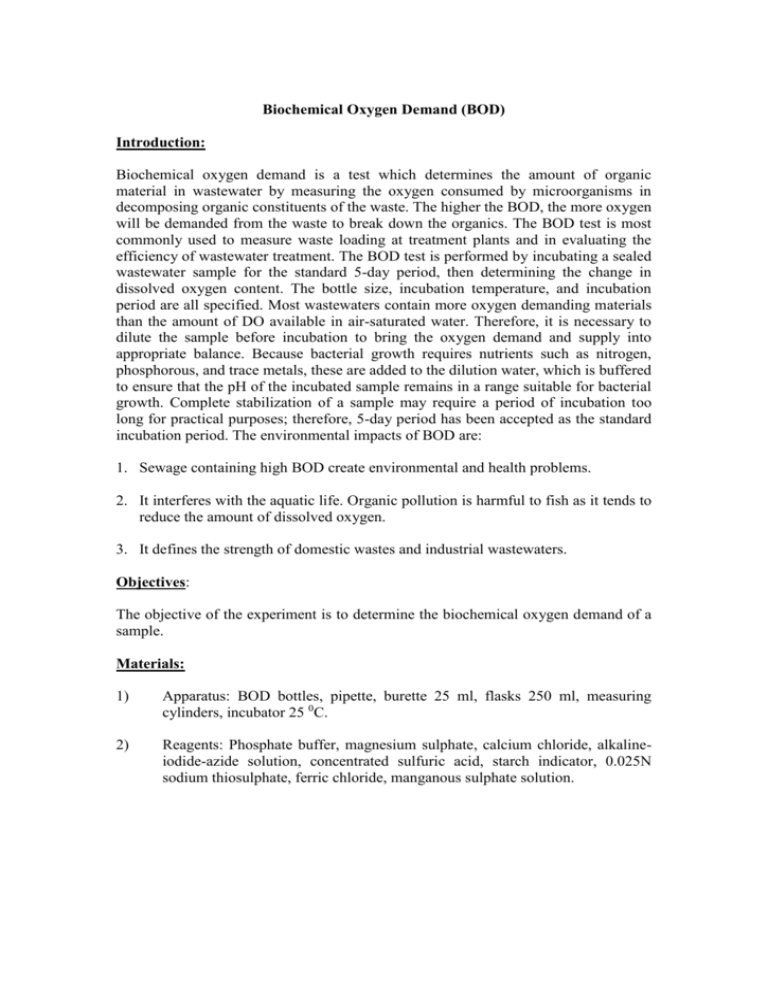
Biochemical Oxygen Demand (BOD) Introduction: Biochemical oxygen demand is a test which determines the amount of organic material in wastewater by measuring the oxygen consumed by microorganisms in decomposing organic constituents of the waste. The higher the BOD, the more oxygen will be demanded from the waste to break down the organics. The BOD test is most commonly used to measure waste loading at treatment plants and in evaluating the efficiency of wastewater treatment. The BOD test is performed by incubating a sealed wastewater sample for the standard 5-day period, then determining the change in dissolved oxygen content. The bottle size, incubation temperature, and incubation period are all specified. Most wastewaters contain more oxygen demanding materials than the amount of DO available in air-saturated water. Therefore, it is necessary to dilute the sample before incubation to bring the oxygen demand and supply into appropriate balance. Because bacterial growth requires nutrients such as nitrogen, phosphorous, and trace metals, these are added to the dilution water, which is buffered to ensure that the pH of the incubated sample remains in a range suitable for bacterial growth. Complete stabilization of a sample may require a period of incubation too long for practical purposes; therefore, 5-day period has been accepted as the standard incubation period. The environmental impacts of BOD are: 1. Sewage containing high BOD create environmental and health problems. 2. It interferes with the aquatic life. Organic pollution is harmful to fish as it tends to reduce the amount of dissolved oxygen. 3. It defines the strength of domestic wastes and industrial wastewaters. Objectives: The objective of the experiment is to determine the biochemical oxygen demand of a sample. Materials: 1) Apparatus: BOD bottles, pipette, burette 25 ml, flasks 250 ml, measuring cylinders, incubator 25 0C. 2) Reagents: Phosphate buffer, magnesium sulphate, calcium chloride, alkalineiodide-azide solution, concentrated sulfuric acid, starch indicator, 0.025N sodium thiosulphate, ferric chloride, manganous sulphate solution. Procedure Winkler Method (samples do not require seeding) Prepare dilution water by aerating distilled water for several hours. Transfer 2l into an aspirator bottle and add 2 ml each of magnesium sulphate, phosphate buffer, calcium chloride, and ferric chloride. Fill two bottles designated as control with the dilution water (B1 and B2). If seed is required add 0.2% seed material into the dilution water Add carefully ---- ml of sample as per Table 1 to two bottles and fill them with the dilution water (D1 and D2). Add 2 ml manganous sulphate, solution to each bottle B1 and D1 immersing tip of the pipette below the surface of the water. Add 2 ml alkali-iodide-azide solution to the bottles immersing the tip of the pipette. Stopper the bottle tight, invert and mix thoroughly. When the precipitate settles halfway, add 2 ml conc. Sulphuric acid to each bottle and invert them and shake well. The color of the solution turns orange/yellow. Place 203 ml of sample in a flask. Fill a burette with 0.025 N sodium thiosulphate solution and titrate the sample till yellow tinge remains. Add 1 ml starch and titrate till the solution becomes colorless. Record the burette readings as mg/l DO for B1 and D1. Incubate the bottles B2 and D2 for 5 days. After 5 days find out DO by the same procedure. Calculation BOD ( mg/l) = ( D1 – D2) – ( B1 – B2) --------------------------( diluted sample without seeding) P BOD ( mg/l) = ( D1 – D2) – ( B1 – B2)*f --------------------------( diluted sample with seeding) P Where: D1: initial DO of sample before incubation D2: Final DO of sample after incubation B1: initial DO of control before incubation B2: Final DO of control after incubation P: Decimal fraction of sample, 100/ml F: Volume of seed in diluted sample / volume of seed in seed control Discussion Discuss the analysis that you have conducted Sample Calibration A seeded BOD5 analysis was conducted on a wastewater sample. 6ml of sample was added to each BOD bottle (300 ml capacity). The seed concentration was 0.2%. Calculate BOD5 of the wastewater from the following data. Dilution p (%) Seed % Control --- 0.2 (100) 100 Sample 2% Mg/l BOD5 = 0.2 (100 2) 100 IDO Bottle DO # mg/l BOD5 mg/l B1 8.9 B2 7.8 -- D1 8.8 D2 3.6 206.1 (D1 D 2 ) (B1 B 2 ) f p = (8.8 3.6) [(8.9 7.8) f ] f= FDO Bottle D0 # mg/l 100 2 0.2 (100 2) 0.2 100 0.196 / 0.98 100 100 0.200 = (8.8 3.6 [(8.9 7.8) .98] 100 206.1 mg / l 2 Table 1. Suggested wastewater dilution for BOD test. % Wastewater Range of BOD mg/l 0.10 0.20 0.50 1.00 2.00 5.00 10.00 20.00 50.00 2000 to 7000 1000 to 3500 400 to 1400 200 to 700 100 to 350 40 to 140 20 to 70 10 to 35 4 to 14
